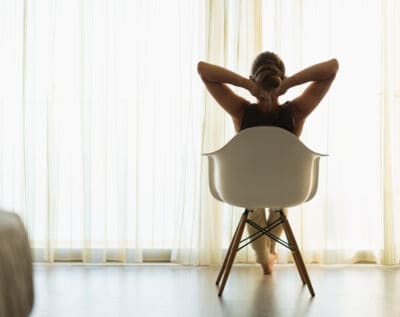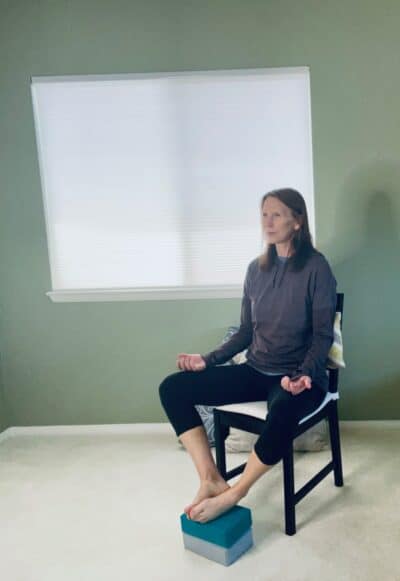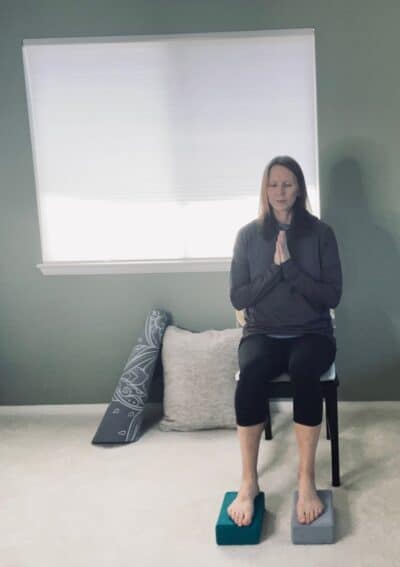Wonderful Chair Yoga Benefits-Healing And Stress Reduction
So, if you’ve been practicing yoga for a bit, or even if you haven’t, you are most likely familiar with the fact that yoga can be a great way to help decrease stress, deal with anxiety, and improve overall well- being. Research on yoga as it relates to well-being is becoming more plentiful. We can absolutely get all the great restorative and healing benefits of yoga in the chair. Keep reading for some simple tips and chair yoga benefits of healing or if you are looking for a Restorative Chair Yoga Sequence, you can find it here: 20 Minute Restorative Chair Yoga: Stretch And Relax.
Or if you are interested in learning more, you can take a look at some research here:
Yoga, mindfulness-based stress reduction and stress-related physiological measures: A meta-analysis
Research Trends in the Application of Yoga to Human Health: A Data Science Approach – PMC
This post contains affiliate links. I earn from qualifying purchases. This means that I may earn a commission should you choose to sign up for a program or make a purchase using my link. This is at no extra cost to you. I only recommend products that I truly believe are helpful. See our Privacy Policy and Disclosures page.
Yoga, The Nervous System, And You
Yoga has far reaching effects on the systems of the body. It affects the nervous system with its focus on breathing and mindfulness. It affects the musculoskeletal system and cardiovascular systems as we perform poses and movements to increase our heart rate, respiratory rate, and our oxygen consumption- as well as improve range of motion and flexibility.
One of the great chair yoga benefits is that it helps to regulate our nervous system through our breathing. The way that we breathe can be an indicator of how we are feeling. If our breathing is shallow and fast, we probably feel a bit frantic and unfocused. If we are taking nice deep breaths from the belly with full exhales, we probably feel relaxed and in control. Breathing is controlled by our nervous system, specifically the autonomic nervous system, but we can have control over how that breathing looks and how it makes us feel.
Our nervous system is most definitely complex, but you are most likely familiar with the two parts of the autonomic nervous system- the parasympathetic and the sympathetic. In a nutshell, the parasympathetic nervous system is the half that deals with resting, digesting, and being calm and the sympathetic gives us the energy and stimulation to work and survive. It is the “fight or flight” part of the nervous system.
We most definitely need both of them for survival, but if we are constantly in a state of sympathetic dominance- we won’t feel very good overall. When we are in a sympathetic dominant state we can’t really think well. We are just trying to survive. This also has huge impacts on our safety. When we are experiencing fear and anxiety related to falling, for example, our breathing may become fast and shallow and our muscles may be tense. We cannot hear and process instructions when we are in a sympathetic dominant state. It also isn’t a good feeling over all. Keep reading for some ways breathing can help and then some practical and simple ways to get started with chair yoga.
How We Breathe Matters
Of course, there are many factors at play here and yoga is not a fix for everything. But, it can help us to take a step back, assess the situation and how we are feeling, and come at the task in a way that might be more productive. Yoga and breathing exercises can help us to shift the balance of the sympathetic and parasympathetic dominance to allow it to be a bit more functional.
You may be interested to know that breathing is an important way that our body rids itself of toxins. When we are not breathing deeply and getting that adequate exchange of oxygen and carbon dioxide, we may find issues popping up here and there that affect our physical and mental health and well being.
By breathing in through our nose, we get a built in filtering process that we miss out on if we breathe in through our mouth. Nice deep breaths also allow our lymphatic system to be stimulated and this helps our skin rid of toxins and inflammation- one of the reasons we get a nice glow on the skin when we exercise.
Nice full deep breaths allow our parasympathetic nervous system to become dominant-which takes us to the healing part. Our bodies can’t heal when our sympathetic nervous system is dominant. It can be very stressful to be in the hospital and to be recovering from a surgery or illness, but we can not heal when we are in a sympathetic state of fight or flight. Focusing on breathing is a great way to start that process.
So, this is not meant to be an exhaustive and in depth look at the healing process, it’s just not that simple. Always consult with your healthcare provider for your medical and mental health needs. But, there is nothing to lose by taking a deep breath and a moment to clear your mind and relax your body before you embark on a difficult task. Yoga has many restorative poses that we can try. Keep reading for some quick and simple chair yoga benefits and tips for calming and relieving stress.

3 Ways To Decrease Stress With Chair Yoga
1. Breathing
I can’t say enough about the power of a deep breath. We have to breathe anyway, so I always say you might as well make it count. Doing yoga poses is a helpful way to encourage deep breathing as you move with the breath. I always notice that if I do not practice yoga for a day or two, my natural breathing becomes less deep and I have to remind myself to take deeper breaths. You can start by just doing this simple breathing exercise:
- Begin seated in a comfortable position.
- Bend your elbows and place your hands on top of your head.
- Gently stretch the elbows apart to open through the chest. Don’t force or strain here, just rest the hands on the head. If you can not place the hands on the top of the head, grasp the opposite hand to the opposite elbow and lift the elbows up as much as is comfortable.
- Take a deep breath in and out through the belly. The idea is to have the belly rise and not the chest. That ensures that you are taking nice deep diaphragmatic breaths.
- Try 2 or 3 breaths here and then relax the arms down.
- Work up to 10 breaths if that is comfortable for you.
You can also do one arm at a time. If you are unable to lift the arms, simply leave them by your sides as you breathe into the belly. Having the arms lifted in this manner allows the chest to open and to stretch the muscles between the ribs that assist with breathing. However, always do what is right for you- don’t ever force or strain. You can always do this lying down in bed- place one hand on the belly and one on the chest. Aim to have the hand on the belly rise more than the hand on the chest.
2. Vagus nerve stimulation
You may or may not be familiar with the vagus nerve. It is one of our cranial nerves and, among some other reflex actions in the body, its responsibilities include regulation of digestion, heart rate, and respiratory rate. It runs from the brain stem, down both sides of the neck, and down to the abdomen. It is involved in healing. It is actually a quite complex topic, but here are 3 easy ways to stimulate the vagus nerve – and you may already be doing them:
1. Humming or singing
2. Cold compress to the front or sides of the neck
3, Neck stretch:
- Begin seated or standing, inhale to lengthen the spine.
- Exhale as you gently bring the right ear towards the right shoulder- only as much as is comfortable, don’t force or strain.
- You may choose to place the right hand on top of the head to feel a sense of grounding- don’t force or push with the hand. You may choose to look up towards the sky with just your eyes and notice how that changes the stretch.
- Hold for 2-3 breaths.
- On an exhale, gently release back to center and repeat on the other side.
3. Restorative poses
Try these two restorative poses that are easily accessible to perform in the chair. You can grab some yoga blocks at stores like Marshalls or Target. I grabbed these at 5 Below. Here is a relatively inexpensive one here: yoga block , or this set of 2.
Bound Angle:
- You will need 2 yoga blocks or a stack of sturdy books or a thick pillow.
- Begin with a long spine and sit all the way back in the chair.
- Place a small pillow or rolled up towel in the low back to support the spine as needed.
- Allow the hips to open out to the sides and place the soles of the feet together.
- Take nice deep breaths as you allow the hips to stretch and feel the support of the chair.
- Stay here for 5 minutes or more as tolerated.

Hands to Heart:
- Sit all the way back in your chair with a long spine.
- Place a small pillow or rolled up towel in the low back to support the spine as needed.
- Ensure that the feet are firmly on the ground- place yoga blocks or books under the feet as needed.
- Place the palms together at the heart.
- Shoulders are down away from the ears.
- Take nice long breaths here as you feel the support of the chair and the earth.
- Stay here for 5 minutes or longer as desired.

If you are interested in more restorative poses performed on the floor or in the bed, I recommend this book, Restorative Yoga for Beginners, because it goes through several different restorative poses with easy to follow instructions, tips, and benefits. It also has several different routines where you can combine the poses for full sequences.
I hope that you have found some simple and practical tips to help you on your healing journey. This is a complex subject and these ideas are not exhaustive or comprehensive. My goal is to offer yoga poses and resources that are accessible and easy to use- and maybe inspire some more exploration!
Want More?
If you are new to chair yoga, take a look at Is Chair Yoga Right for You?
You may be interested in Breathing For Better Mobility
You may enjoy reading about the 7 Types Of Rest
If you are a caregiver or healthcare worker, you may like Self Care For Caregivers
If you are interested in learning about the Chakras- take a look at Chair Yoga For Grounding to get started.
You may be interested in these bracelets that can help us manage anxiety: Presently Bracelets
I like these affirmation cards to help create some positivity in the day: 52 Positive Affirmation Cards
Or, you may be interested in my Daily Journal Notebook
Finally, visit The Peaceful Chair YouTube Channel for chair yoga videos.
I invite you to sign up for the Monthly Email Newsletter to help you stay up to date on the latest blog posts, videos, and printable pages.
Namaste!
Disclaimer: The Peaceful Chair and thepeacefulchair.com strongly recommends that you consult with your physician before starting this or any exercise program.The information provided on this website is for informational purposes only and is not to be used in place of medical advice or information from your healthcare provider. Neither The Peaceful Chair, the peacefulchair.com, nor any of its contributors shall be held liable for any improper or incorrect use of the information described and/or contained herein and assumes no responsibility for anyone’s use of the information contained in any links, videos, or any content on this website.

Leave A Comment